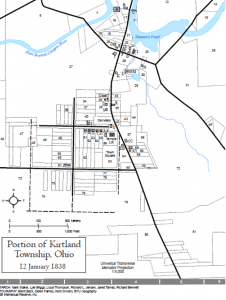Historical Context and Background of D&C 94

Video Overview
Brief Synopsis by Steven C. Harper
Section 94 may make more sense after you have studied sections 95, 96, and 97, because it was actually revealed right after section 97, though for many years it was misdated and thus misplaced. It makes the most sense when it is read as an extension of section 97.1 It addresses similar concerns as section 97 and says that the Lord had already revealed the pattern for the House of the Lord in Kirtland, which he did in section 95.
In section 97 the Lord required the Saints in Missouri to build a temple. In section 94 he commands the Saints in Ohio to build a stake to Zion, beginning with another temple in Ohio, as commanded in section 88 and again in section 95. The Lord calls for the construction of an office for the First Presidency next to the temple in Kirtland, Ohio. He specifies its design and the conditions on which he will abide there. On the next lot south the Lord wants a printing office, perhaps to replace the Church’s press destroyed by a mob just a few days earlier in Missouri (unbeknownst to Joseph). The members of the Church’s building committee—Hyrum Smith, Reynolds Cahoon, and Jared Carter—are appointed lots or “inheritances” near the building sites. Verse 16 is not in the early manuscripts. Joseph probably added it as clarification before the revelation was published in the 1835 Doctrine and Covenants.
In the letter to Missouri Church leaders that included section 94, the First Presidency explained that the Saints in Zion should build similar buildings for meetings and printing the scriptures.2 But the Saints in Zion were already being forced from their land and homes, and Saints in Kirtland struggled to muster enough resources to build the temple. They eventually scaled down the instructions in section 94, built one building instead of two, and used it as a printing office, a school, and office space for the First Presidency.
1. “Revelation, 2 August 1833–B [D&C 94],” p. 64, The Joseph Smith Papers, accessed July 9, 2020.
2. “Letter to Church Leaders in Jackson County, Missouri, 6 August 1833,” p. [1], The Joseph Smith Papers, accessed July 9, 2020.
Additional Context by Casey Paul Griffiths
From Doctrine and Covenants Minute
In the summer of 1833, the construction of the temple in Kirtland, Ohio, was beginning to gain momentum. Around this time, Church leaders in Kirtland also sent architectural plans to Church members in Zion to build another house of the Lord in Independence, Missouri. Along with these plans, they sent along the plat for the city of Zion.1 The temple was located at the center of the city of Zion—just as it was in Kirtland. The Lord refers to Kirtland in this revelation as “the city of the stake of Zion” (D&C 94:2).
Framing this revelation in his history, Joseph Smith wrote, “A conference of high priests assembled in Kirtland, to take into consideration the necessity of building a school-house, for the accommodation of the elders, who should come together to receive instruction preparatory for their missions and ministry, according to a revelation on that subject, given March 8th. 1833 [D&C 90].”2 This revelation instructed Church leaders to lay out a plan for building Kirtland up to be “the city of the stake of Zion.” It also gave instructions to build two additional buildings: a house for the presidency and a house for the printing of the scriptures (D&C 94:3, 10). A third building designated in an earlier revelation (D&C 88:119) was intended to serve as a home to the “school of the prophets” (D&C 90:7) and became the Kirtland Temple, where the Savior, as well as Moses, Elias, and Elijah, appeared to give priesthood keys to Joseph Smith and Oliver Cowdery (D&C 110).
This revelation was incorrectly dated to May 6, 1833, when it was first given a date in the 1876 edition of the Doctrine and Covenants. From the evidence that is available, this section appears to have been received on the same day as section 97. When the revelation was originally recorded in Revelation Book 2, it was given its own heading and date, recorded as “Kirtland 2nd August 1833.”3 However, when it was later recorded into Revelation Book 1, it was included as part of a letter written to Church leaders in Jackson County that is dated August 6, 1833.4 When the 1835 edition of the Doctrine and Covenants was published, this revelation was apparently mistakenly inserted after Doctrine and Covenants 93 with a heading that read “revelation given the same date.” This wording gave the impression that the revelation was received on May 6, 1833, the same date that section 93 was received.5 This mistake in the revelation’s date continued until the 2013 edition of the Doctrine and Covenants, when historians from the Joseph Smith Papers were able to correct the date.
See “Historical Introduction,” Revelation, 2 August 1833–B [D&C 94]
1. See Plan of the House of the Lord, between 1 and 25 June 1833, JSP; and Plat of the City of Zion, circa Early June–25 June 1833, JSP.
2. JS History, vol. A-1, p. 291, JSP. The Prophet’s history, written several years after this revelation was given, gives the incorrect date for this revelation as May 6, 1833. According to available evidence, the revelation was most likely received later that summer on August 2, 1833.
3. Revelation Book 2, p. 64, JSP.
4. Letter to Church Leaders in Jackson County, Missouri, 6 August 1833, JSP.
5. Doctrine and Covenants, 1835, p. 213, JSP.
